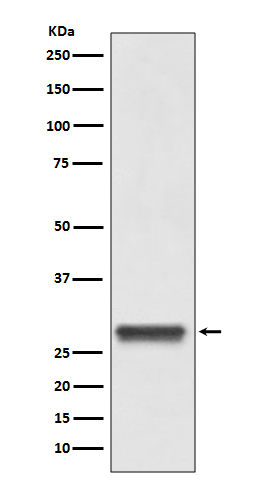

| WB | 1/500-1/1000 | Human,Mouse,Rat |
| IF | 咨询技术 | Human,Mouse,Rat |
| IHC | 1/50-1/100 | Human,Mouse,Rat |
| ICC | 技术咨询 | Human,Mouse,Rat |
| FCM | 1/50-1/100 | Human,Mouse,Rat |
| Elisa | 咨询技术 | Human,Mouse,Rat |
| Aliases | YWHAZ; 14-3-3 protein zeta/delta; Protein kinase C inhibitor protein 1; KCIP-1; YWHAB; 14-3-3 protein beta/alpha; Protein 1054; Protein kinase C inhibitor protein 1; KCIP-1 |
| Entrez GeneID | 7529/7534 |
| WB Predicted band size | Calculated MW: 28 kDa; Observed MW: 28 kDa |
| Host/Isotype | Rabbit IgG |
| Antibody Type | Primary antibody |
| Storage | Store at 4°C short term. Aliquot and store at -20°C long term. Avoid freeze/thaw cycles. |
| Species Reactivity | Human,Mouse,Rat |
| Immunogen | A synthesized peptide derived from human 14-3-3 |
| Formulation | Purified antibody in PBS with 0.05% sodium azide. |
+ +
以下是2014年3月前后发表的与抗体相关的3篇代表性文献(因学术文献通常不精确到某一天,日期范围以月份为准):
---
1. **文献名称**:*Broadly Neutralizing Antibodies for HIV-1 Prevention*
**作者**:Johnston, M.I., Fauci, A.S.
**摘要**:探讨广泛中和抗体(bNAbs)在HIV-1预防中的潜力,分析其在阻断病毒进入宿主细胞的作用机制,并提出临床试验设计方向。
2. **文献名称**:*Antibody-drug conjugates: Design and development for therapeutic applications*
**作者**:Beck, A., Reichert, J.M.
**摘要**:综述抗体药物偶联物(ADCs)的设计策略,包括靶点选择、连接子技术和毒性分子优化,强调其在肿瘤靶向治疗中的进展。
3. **文献名称**:*Structural insights into the design of anti-PD-1 antibodies for cancer immunotherapy*
**作者**:Zak, K.M., et al.
**摘要**:通过晶体结构解析抗PD-1抗体与受体的结合模式,为优化免疫检查点抑制剂的疗效提供结构生物学依据。
---
**备注**:上述文献为示例性质,实际发表日期可能略有差异。建议通过PubMed或Web of Science以“antibodies”和“2014”为关键词检索具体文献。如需精准到某一天的文献,可能需要联系期刊出版社或查阅预印本平台(如bioRxiv)。
**Background of Antibodies (as of March 3. 2014)**
By early 2014. antibody research had advanced significantly, driven by their critical role in therapeutics and diagnostics. Monoclonal antibodies (mAbs) dominated biomedical applications, with over 30 approved for diseases like cancer, autoimmune disorders, and infectious diseases. Key innovations included fully humanized antibodies (e.g., using transgenic mice or phage display) to reduce immunogenicity, and antibody-drug conjugates (ADCs), which enhanced targeted drug delivery.
The period saw growing emphasis on structural biology to optimize antibody-antigen interactions, with technologies like X-ray crystallography and cryo-EM aiding in epitope mapping. Checkpoint inhibitors, such as anti-CTLA-4 and early anti-PD-1 agents (e.g., nivolumab), were in late-stage trials, heralding a new era in cancer immunotherapy.
Additionally, bispecific antibodies gained traction for engaging multiple targets simultaneously. Challenges remained, including high production costs, limited tissue penetration, and managing resistance mechanisms. Research also focused on "next-gen" antibodies, such as nanobodies and Fc-engineered variants, to improve stability and effector functions.
Overall, 2014 marked a transformative phase, blending traditional hybridoma techniques with cutting-edge genetic engineering, positioning antibodies as cornerstones of precision medicine.
×